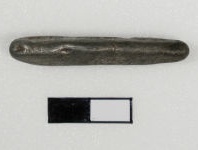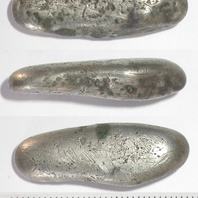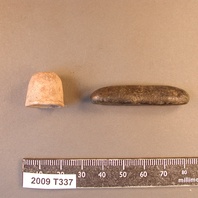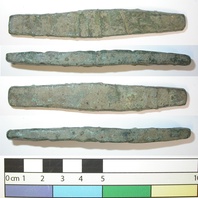
Viking Objects
Silver Ingot (2010-195)
Ingots of this size and shape were used as a convenient way to store and carry silver in the Viking Age. They might be cut up into pieces (hacksilver) to be used as bullion for payments, or be processed into jewellery. Analysis of silver ingots from this period shows that many were made from silver mined in the Middle East. This silver was probably originally used to mint Arabic dirhams (a type of coin) but was melted down by the Vikings to make it more easily portable.
Read More

Viking Objects
Breedon Silver Ingot (X.A236.2009.0.0)
A Viking silver ingot which could have been used as bullion in payments or trade transactions, as well as a source of metal for jewellery making. The Vikings arriving in England had a bullion economy where they paid for goods with silver that was weighed to an amount agreed between the buyer and the seller. Hacksilver and silver ingots are the most common evidence for their bullion economy. It took some time for the Scandinavian settlers to adopt a monetary economy like that of the Anglo-Saxons, and both systems were used simultaneously for a while before they fully adopted the new system. They were familiar with monetary economies but they treated coins as just another form of silver before adoption of a monetary economy.
Read More

Viking Objects
Breedon Silver Ingot (X.A208.2010.0.0)
A cast silver ingot of typical Viking type. The photograph shows it alongside a lead gaming piece of a type that is increasingly being found within the Danelaw. This ingot could have been used as bullion in payments or trade transactions, as well as a source of metal for jewellery making. This particular ingot has slight irregularities from being made in an open mould and has two testing nicks on one edge. The Vikings arriving in England had a bullion economy where they paid for goods with silver that was weighed to an amount agreed between the buyer and the seller. Hacksilver and silver ingots are the most common evidence for their bullion economy. It took some time for the Scandinavian settlers to adopt a monetary economy like that of the Anglo-Saxons, and both systems were used simultaneously for a while before they fully adopted the new system. They were familiar with monetary economies but they treated coins as just another form of silver before adoption of a monetary economy.
Read More

Viking Objects
Copper Alloy Ingot (1986/975-AE29)
This copper alloy ingot was found at the Little Chester Roman fort site near the Roman defences of Derby. This item, alongside others found in the ditches and structures close to the Roman defences, suggests a high level of activity in the area and a significant early medieval presence at this stronghold. Being found in proximity to a stone mould, it is likely that this ingot was used for metalworking, probably of jewellery. Similar ingots are known from Viking period contexts in northern Europe, as at Birka and Lund.
